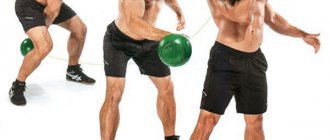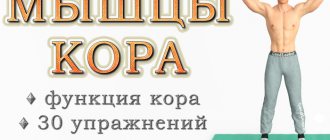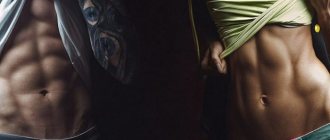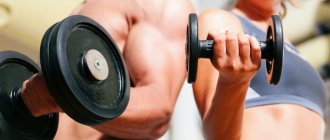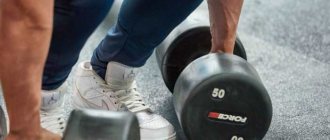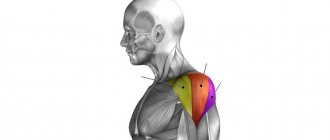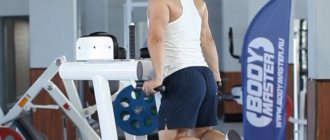Broad shoulders and sculpted abs are undoubtedly beautiful, but it’s even more admirable when all this is complemented by pumped-up breasts. To achieve results in pumping up your upper body, making it powerful and attractive, you need to regularly work out in the gym. This material will talk about effective exercises for pumping up the pectoral muscles.
It is better to train this muscle group twice a week with a break between classes of at least two days. Program for beginners - one or two exercises and no more than 3 approaches, to gain muscle mass - 10-12 repetitions, for strengthening - 6-8 repetitions. Since chest training is closely related to triceps work, the schedule should be designed so that exercises for these muscle groups are not included in the same session.
Top 3 mistakes in chest training
Loading your chest 4 times a week is just wasting your time, especially if you have a thin physique.
- Isolation exercises. You won't be able to stimulate your chest muscles with heavy weights using exercises like dumbbell flyes. This means that you will not be able to achieve the same release of testosterone and growth hormone as during basic exercises.
- Poor diet. You can’t count on gaining voluminous breasts if you are 180 cm tall and weigh only 55 kg. If you don't eat more, working out three times a week won't do you any good.
- Divided into upper, middle and lower. Despite the fact that the chest has two large heads, it is one muscle that contracts entirely. You cannot separate the upper part of the chest from the lower part, you can only focus on one of them.
Anatomy of the chest muscles
The pectorals are one of the three largest muscle groups. They are located above the abdominals.
The main muscles can be identified:
- Pectoralis major muscle . This is the largest muscle of this group. It is on its development that we will spend 90% of our efforts. Conventionally, it is divided into three zones: upper (least developed and weakest), middle (largest zone, which gives volume to the breasts), lower (anatomically the strongest).
- Small chest. Located under the pectoralis major muscle. Its development will help increase breast size, making it more massive.
Their function is to bring the arm to the body. That is, if we spread our arms to the sides, then in order to bring them together in front of us we will connect the pectoral muscles.
And there are also secondary muscles, but this does not mean that they are less important than the main ones:
- Serratus anterior muscles. They help the rhomboids bring the shoulder blades together, thereby stretching the pectoralis major muscles more.
- Subclavius muscle. Responsible for the movement of the collarbone.
Good development of this muscle group increases the volume of the chest. Such a change will visually affect the breasts themselves, visually making them larger.
If you want to learn more about the chest muscles, I advise you to read my article "
Anatomy of the pectoral muscles."
Tips for gaining breast mass
The key to getting expressive breasts lies in increased nutrition and impact training. Before you think about isolation exercises, build a strong base.
- Eat better. If you are underweight, you can forget about impressive breasts. Find out the minimum normal body weight relative to your height from tables or using a calculator. To gain weight: eat every 3 hours, giving preference to high-calorie foods. Read articles about the mass-gaining phase and the method of gaining mass without fat.
- Do basic exercises with heavy weights. To strengthen and build overall body muscle for a man, there are no better exercises in the gym than basic free weight exercises such as the squat, deadlift, bench press and military press. Do them often and spare no effort.
- Train your legs. Squats and deadlifts accelerate chest growth due to the powerful release of testosterone and growth hormone, which provoke the synthesis of muscle tissue. Strengthen your leg muscles. Check out 5 reasons to work out your leg muscles.
- Rest. Muscles grow after training, not during it. Avoid loading your breasts more than twice a week. Keep your caloric intake in check to ensure your babies get all the nutrients they need to recover and grow.
- Press in jerks. This way you recruit more muscle fibers, which allows you to lift heavier weights and achieve better results. Perform all presses and pull-ups quickly, making sure the technique is correct. Lower the weight in a controlled manner, but not too slowly.
- Use proper technique. The partial range bench press will not work the pecs as well as they should. At the bottom of the movement, touch the bar to the T-shirt, at the top, fully straighten your elbows. If necessary, take lighter weights.
- Set realistic goals. Even if you train and eat exactly like your idol, you will never achieve the same muscle shape. Muscle development is influenced by sport and diet. But their shape is determined only by genetics.
- Be patient. Especially if you are still a teenager. Your body is still growing. There is no way a 15 year old can build the muscles of a 30 year old. Build your base and be patient. As you age, you will notice welcome changes in your muscles.
Nutrition for muscle growth
We have already figured out how to properly pump up our breasts, it’s time to decide on nutrition so that they grow well and training gives visible results as quickly as possible.
Don't eat too many calories
It is naive to believe that the more calories you consume, the larger and stronger your muscles will be. Calories are needed for energy, which will be needed during training. And if the caloric intake is too high, then the body will increase fat reserves rather than muscle. You need to maintain your optimal energy balance with a slight surplus of 500 calories so that your muscles get enough energy to grow and your pecs look more prominent.
- Do not eat foods with empty carbohydrates (pasta, white bread, cakes, cookies and other baked goods). Choose whole grains.
- Avoid eating too many processed or fried foods and limit fast foods and snacks.
Eat plenty of protein
Protein is the building blocks of muscle fibers, so you need to consume enough protein foods to have large, strong chest muscles. Protein is found in many foods, not just meat. Here are some of the protein sources:
- Lean meat (chicken, fish, lean beef and pork);
- Eggs and dairy products;
- Nuts and beans;
- Cabbage, spinach and other vegetables with protein;
- Tofu and soy.
3. Consider taking a supplement
Very often, along with working out and eating right, people often take creatine monohydrate, which is a powdered supplement that you dissolve in water and drink 3 or more times a day.
- You can try protein shakes. They are one of the most useful supplements for muscle growth and for maintaining overall physical fitness.
Read more: which protein is best for weight gain.
Top 4 Exercises to Build Your Chest
When bench pressing, avoid touching your neck or splaying your elbows out to the sides. Both options are potentially dangerous and can injure your shoulders. Focus on exercises that will allow you to progress with the weights without compromising your health.
- Bench press. Allows you to load your muscles with heavy weights. Say goodbye to big pecs if you can't bench press your bodyweight at least 5 times for 5 sets (at 75kg you should bench press 75kg 5x5).
- Push ups. Closed circle exercise. Unless you use weights. Do push-ups with an expander or weights.
- Weighted parallel bars push-ups. Option for athletes with healthy shoulders: Do parallel bars while wearing a weight belt.
- Dumbbell press . Stimulate the growth of the pectoral muscles by stretching them at the lowest point of the amplitude. But the weight will have to be taken less than with a barbell press.
Read the article on how to gain mass, which describes most of the above principles for increasing the strength and size of the pectoral muscles.
Small size
This notorious problem haunts many women, but there are many men for whom this “disadvantage” is an advantage. Well, the truth is, not everyone likes a big bust! In addition, modern underwear with a modeling (read: “deceptive” effect) quite successfully solves this problem.
Solution: The chest can be made larger by developing the pectoral muscles. Of course, the mammary glands themselves will not grow, but an increase in muscle mass underneath them will give the necessary visual effect.
Improve the shape of your breasts from the bottom bun to the top!
If you're serious about improving your upper torso, give this workout a try. You'll be lifting enormous weights, challenging every muscle fiber, aiming for high training volume, and leaving the gym completely exhausted!
Athlete and elite bodybuilding coach Dylan Thomas doesn't always train pecs on Mondays and shares his secrets on how to pump up pectoral muscles in the gym for every man. He uses a set of exercises that maximally stimulates all processes associated with muscle growth and loads every muscle fiber from the bottom to the top of the chest.
He shares: “When working the chest, I like to work from the top to the bottom. This means I start on an incline with my head up, then move to a flat surface, and then I do incline exercises with my head down, or dips.”
His one-hour chest workout program includes other exercises as well. Pre-fatigue? Eat. Heavy weights for mechanical stress? Eat. Supersets and sets to failure for maximum muscle destruction? There is another way.
Don’t let the same type of exercises and repetition schemes fool you. This is advanced bodybuilding of the highest standard, and it is perfect for everyone who wants to reach heights.
Thomas says, “I like to do this routine to sharpen my contours before a photo shoot or competition.”
Loose skin
The reason is her poor tone. Both a strong addiction to hot baths and improper hygienic and cosmetic care of the chest area may be to blame for this.
| By the way | |
| Wraps, compresses, masks are best done from 18:00 to 22:00. At this time, the skin is more receptive to nutrients. However, there are no remedies that work equally for all women. Choose the optimal combination of techniques and medications for yourself. Or seek advice from a specialist. Don't expect too quick results. Only after a few months of regular training can you notice the first successes. | |
Solution: Wash your breasts daily with warm water and liquid soap or gel, and then be sure to rinse them with cool water. It is better not to wipe off the moisture, but to let it dry on its own; this helps moisturize the breasts better than any cream. If time is limited, pat your skin dry with a soft towel and then be sure to apply moisturizer. When washing, you can use decoctions of herbs - St. John's wort, thyme, anise fruits, eucalyptus leaves (brew 1 tablespoon with a liter of boiling water). 1 tbsp. Brew a spoonful of a mixture of green and black tea (in equal proportions) with a glass of boiling water. You can add 1 tbsp to a decoction of rose hips (2 tablespoons per 1 glass of boiling water). a spoonful of honey, if there is no allergy. Rinse your chest with these decoctions.
To increase the elasticity of the bust skin, you can also use massage with water jets. When taking a shower, use warm water from a hose to massage the entire rib area under the chest and sides in a circular motion for 5-7 minutes. Then move on to the cervicothoracic muscles, rise from the mammary glands to the shoulders, then massage the armpit area and shoulders. Repeat the procedure with cool water. Instead of a shower, you can use a regular bathing mitt made of hard terry cloth - with light massaging movements, wash your breasts with hot, then cool water.
Salt and cold can be used to tone the skin of the chest.
Wet a bath mitten with cool water, squeeze lightly and sprinkle with salt. Using circular motions, lightly massage the skin around your breasts. Rinse with cool water and apply cream.
Roll up your bra, put it in a plastic bag and stick it in the freezer, then put it on and walk around for 2 minutes.
Chest muscle training program
Watch the video:
In the video, Thomas talks and shows how to pump up your chest in the gym, using basic and isolation exercises to work out the upper, middle and lower parts of the pecs. This is a very effective training program designed specifically to train all the bundles in one day.
| 1. Superset: 4 laps Reduction of arms in the butterfly simulator 12 reps Incline dumbbell press with head up 12 reps | |
| 2 . Incline bench press head up 4 sets of 6 reps | |
| 3. Superset: 4 lapsBringing your arms together in a crossover 12 reps Bench press 8 reps | |
| 4. Triset: 4 circles Dips 10 reps Pushups 10 reps with push-ups or dumbbells Bringing your hands together in a crossover from bottom to top 10 reps | |
| 5 . Dumbbell flyes 3 sets of 12 reps |
FAQ
1. How to quickly build chest muscles?
Perform push-ups, bench presses and dumbbells, working to the maximum in each exercise. Train twice a week with two days between visits to the gym for 8 weeks. If the amount of protein you get from food is not enough, take supplements before and after your workout. Keep your body mass index below 24 to prevent muscles from hiding under fat folds.
2. What should you eat?
Adequate protein intake (20% of total calories) will help provide the body with enough of the right nutrients to gain muscle mass.
3. What type of exercise is the most effective?
In order for muscles to grow, they need to be stressed by increasing the load, which is more easily achieved through strength training with weights. Basically, these are basic multi-joint movements in which several joints are involved. Dumbbell and barbell presses on a horizontal bench and lying at an angle of 30-45 degrees are considered the best exercises for gaining mass in the pectoral muscles. But you can practice by performing different movements with your own body weight. It is also worth performing other basic movements to stimulate testosterone production and protein synthesis in the body.
5. What type of push-ups is best for this?
Any type of push-up will provide additional growth stimulation if done correctly.
6. I'm just doing push-ups. Will I pump up my arms and chest?
Push-ups are aimed at working the immediate pectoral muscles, triceps, shoulders, back if done correctly, and even a little core muscle. But to pump up your chest at home, just exercises with your own weight are not enough, so you need to include exercises with weights in your training program. For your arms, push-ups on your fingertips are more suitable.
7. Is it possible to pump up your breasts only with the help of a proper diet?
This is impossible. A diet will not only gain muscle mass in one specific area of the body.
8. Do I need to do push-ups every day?
Yes, you can do push-ups every day.
9. Is it possible to train every day?
Depends on the type of training. Most people exercise mainly 3-4 times a week. Some advise 6 days of training and one day of rest. If you do low sets and high reps, then this approach will be ideal. Just don't overtrain one part of the body, spend time on other parts of the body.
10. How can I make my muscles more prominent?
Train different muscle groups every day. Prepare a plan for 6-7 days so that each day you focus on a specific part of the body. Let's say on Monday you train for the chest muscles, on Tuesday for the triceps, then for the shoulders, biceps, lateral muscles, thighs, abs, and so on. Repeat this cycle week after week, which will give your muscles definition and volume. After each intense workout, give your muscles up to 24 hours to recover and grow.
Adviсe:
- During exercise, remember that the body must receive vitamins. So eat more fruits, vegetables and grains (a little). Try to get sugar only from fruits.
- Warm up before starting your workout.
- Watch the amount of calories you consume; you should not starve either.
- Try to consume food at the same time, without skipping meals.
- Concentrate on the movement, if you do not feel tension in the muscles (shaking), then you are doing something wrong or the weight is not enough. Do the exercise slowly. Slow and steady repetitions are better than fast and erratic movements.
- Go swimming. This is a great way to develop your upper torso muscles.
- Don't stop exercising just because you don't see results after a week.
- Drink plenty of water.
- Listen to music while exercising.
- Don't feel sorry for yourself.
- It is better to pump one muscle group once every 3-4 days or until the discomfort goes away. That is, you pump your chest, 1 day of rest, then you work on, for example, your arms or legs, a day of rest, and you can return to the chest again.
- Vegetarians should eat more protein. Soy products contain large amounts of protein.
- Try to get enough sleep. Muscles need to rest in order to grow.
- Perform the movements correctly. If everything works out, you can add additional weight.
- Consume 0.8 - 1 kg of protein per kilogram of body weight. Get it with meat, milk, chicken, beans, fish and eggs.
Recommendations for exercise technique
Superset: abbreviation in the simulator and dumbbell bench press while lying on an incline bench
Reduction of arms in the simulator / Dumbbell press lying on an inclined bench with your head up
This is a classic method of pre-fatiguing muscle fibers. Its main task is to warm up the pecs and improve blood flow to their upper part before heavy bench presses.
Thomas advises, "Try to fully contract every muscle fiber on every rep."
The same applies to bench presses. “Work rhythmically. Here we need to pump as much blood into the muscles as possible before moving on to incline bench presses with a heavier barbell,” he comments.
Do not straighten your elbows completely, try to work without pauses and at the same pace.
Incline Barbell Press
Incline bench press with head up
Even when training for relief, Dylan takes into account that heavy weights play a key role in maintaining mass and muscle density. Of course, you probably won't be able to press the same weight as if you started the workout with a bench press, but Dylan assures that this will give you a much better feel for the exercise.
“We started with supersets, which give a good pump. Therefore, moving on to the next exercise with heavier weights, we will fully feel each movement, even despite the use of heavy equipment,” explains Thomas.
This part of the training will make you sweat. Don't be afraid to ask someone at the gym to back you up, but use enough weight to get all 6 reps.
Superset: Crossover Bent Over and Bench Press
Bent-over crossover/bench press
The work on the upper portion of the chest is completed. It's time to tackle the middle bun.
Thomas says, "We'll first pre-fatigue the muscles with a lot of crossover crunches and then move on to a moderate-weight bench press."
But even with a large training volume, execution technique is paramount. “Lock your arms at the elbows and try to stretch the muscles as much as possible, opening the chest, before bringing your hands together, squeezing the middle portion of the pecs,” he advises.
With the bench press, you're not so much concentrating on pressing the weight up as you are trying to lower it down in a controlled manner.
Thomas advises: “For this exercise, focus your efforts on the negative part of the movement. This way you activate and injure your chest muscle fibers more. Try to stop the bar a millimeter before it touches your chest, increasing muscle tension, and then smoothly press up.”
Triset: Dips, Dips, Crossovers
Dips/Push-ups/Crossover crossover
After two pre-fatiguing supersets and a couple of heavy presses, your pecs should already be “waking up”, or even “singing”. Now let's focus on stretching the muscles, which contributes to further damage to muscle fibers.
Don't have dip bars? Two parallel bars will do just fine, the main thing is to stick to the classic technique: lower your chin, pull your knees back, stretch the muscles when lowering, and contract when going up.
Push-ups using push-ups also allow you to stretch your muscles. “Don't go all the way up, stopping about 3/4 of the way up, and keep your muscles under constant tension,” advises Thomas.
Bringing your arms together in a crossover is - as you may have guessed - aimed at contracting and stretching the muscles. Step out of the block frame 1-2 steps and lean your body forward slightly to get into the correct starting position. When moving up, raise your arms only to the level of the lower edge of your chest. Squeeze your muscles and lower your arms, stretching your pecs.
If the room is full of people, you can do all sets of several or all exercises at once, or alternate between parallel bars and crossovers with your training partner, while keeping a pair of dumbbells on the floor to do push-ups in between.
Dumbbell flyes
Dumbbell flyes
Nothing new here! Just work with a comfortable weight, find the optimal low point of amplitude for stretching the muscles, and perform the specified number of repetitions. The only recommendation from Thomas is to try to bring your elbows together rather than your arms or dumbbells, as this will cause the pectoral muscles to contract more strongly.
Three approaches and you are free. Now recover, because the next “breast day” is just around the corner!
Training mistakes
Exercises for the chest muscles have gained widespread popularity due to their effectiveness. But at the same time, people make typical mistakes that hinder the growth of the strength of this group:
- Mistake #1. Race for the scales. Despite the fact that the pectoral muscles respond well to working with heavy weights, it is worth remembering that in all basic exercises, the triceps and deltoids take on a decent portion of the load. Therefore, it is better to work the chest with perfect technique and slightly lighter weights.
- Mistake #2. Using only the bench press. Traditionally it is considered that this is the best exercise for the sternum muscles. However, this is not quite true. Ideally, supplement it with exercises and be sure to work on benches with different inclinations.
- Mistake #3. Chop. It helps you lift weights easier and therefore do more repetitions. However, when beating, the impulse component reduces the load on the pectoral muscles and increases the risk of sprains and injuries.
- Mistake #4. Exercise machines are for weaklings. Exercise machines have a fixed, unnatural range of motion, which is why many people consider them ineffective for working out. This is not true. With proper work on the machines, you can improve the performance of a lagging muscle group or concentrate your attention on a separate group. Do them after the main basic presses, but before flyes.
- Mistake #5: Split training with your back or legs. The basic three-piece “press-dead-squat” is only suitable for acquiring basic indicators or for training in powerlifting. In the case when you need to work exclusively on the pectoral muscles separately, the general fatigue accumulated due to deadlifts and squats will not allow you to perform a set of chest exercises with maximum impact. The best option is to combine it with triceps or biceps.


